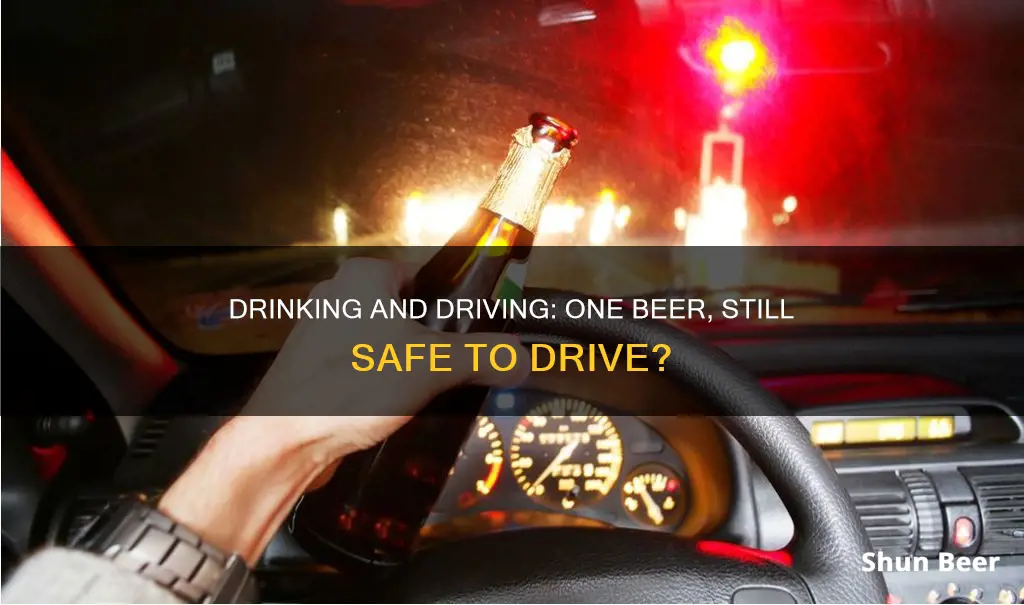
Drinking and driving is a serious issue that can lead to devastating consequences. While many people assume that having one drink and then driving is acceptable, the truth is that even a single drink can impair your judgment and ability to drive safely. Alcohol affects people differently depending on various factors such as body weight, metabolic rate, and food intake. It is absorbed into the bloodstream rapidly and can take over an hour to be processed, meaning that even if you feel sober, your ability to drive may still be compromised. To stay safe, it is best to avoid drinking altogether if you plan to drive or arrange for alternative transportation, such as a designated driver or ridesharing services. The risks of drinking and driving are simply not worth it.
| Characteristics | Values |
|---|---|
| Is it safe to drive after one beer? | No |
| How long does it take to process one alcoholic beverage? | Over an hour |
| What happens after one drink? | Impaired judgment, lack of ability to make informed decisions, impaired vision, inability to accurately gauge depth perception, inability to distinguish different colors |
| What is the legal Blood Alcohol Concentration (BAC) limit? | 0.08% |
| What is the BAC after one drink? | 0.02% |
| What is the BAC after two drinks? | 0.05% |
| What is the BAC after three to four drinks? | 0.08% |
| What is the BAC after five to six drinks? | 0.10% |
| What is the BAC after six or more drinks? | 0.15% |
| What is the BAC limit for young drivers under 21 years of age in Georgia? | 0.02% to 0.05% |
What You'll Learn

One drink can impair judgement and coordination
Even a single drink can affect your ability to drive. Alcohol starts impacting your driving sooner than you might realise. This subtle impairment is what makes driving after drinking dangerous. You may feel sober, but your ability to judge and coordinate could be impaired.
After a single drink, many things begin to occur in the body and the mind. Drinking impairs judgement, and with that comes a lack of ability to make informed decisions with proper thought. Alcohol can also affect your ability to see, causing double vision because it can impair your eye’s ability to focus. This can cause you to lose the ability to accurately gauge depth perception, the ability to perceive how close or how far away something is, speed, and your movement. It can also affect your ability to distinguish different colours, such as the inability to discern green from red. These effects occur at four times lower blood alcohol levels than the legal limit.
Your gender, weight, and health change how fast alcohol hits you. But even one drink makes driving risky. A 140-lb woman may be able to consume 2.5 regular beers in an hour and maintain a blood alcohol concentration (BAC) of less than the legal limit of 0.08%. An 180-lb man may be able to drink 3.5 regular 12-ounce beers in one hour and keep his BAC under the same limit. However, these numbers are general estimates and do not take into account other factors such as an individual’s metabolic rate.
In California, being charged with a DUI does not just hinge on crossing the legal blood alcohol limit. If a police officer believes your driving is impaired, you could face a DUI. It is wiser to err on the side of caution: if you plan to drink, arrange alternative transportation.
Beer and Zyrtec: Is It Safe to Mix?
You may want to see also

Alcohol is absorbed into the bloodstream rapidly
Alcohol is a fast-acting substance that is absorbed into the bloodstream rapidly. As soon as you take your first sip, alcohol enters your bloodstream. Typically, it takes around 10 minutes to feel the effects of alcohol, with peak effects occurring between 30 and 90 minutes after ingestion. However, this can vary depending on several factors.
The absorption rate of alcohol is influenced by various factors. Firstly, drinking on an empty stomach results in a quicker absorption rate. When alcohol is consumed with food, the food acts as a sponge, absorbing some of the alcohol in the stomach and slowing down its passage into the small intestine. Drinking carbonated beverages also increases the absorption rate by creating pressure in the stomach, which pushes alcohol through the stomach lining into the bloodstream.
The type of drink and the amount consumed also play a role. Drinks with higher alcohol content, such as port or rum, tend to raise blood alcohol concentration (BAC) faster than drinks with lower alcohol content, like beer. Additionally, chugging a drink leads to a faster absorption rate compared to sipping it gradually.
Individual factors, such as weight, size, gender, and metabolism, also impact alcohol absorption. Females, for instance, tend to metabolize alcohol at a different rate than males due to lower body water content and higher body fat percentages. Weight and size influence absorption regardless of gender, with smaller and lighter individuals generally absorbing alcohol more quickly.
It is important to note that alcohol affects everyone differently, and there is no one-size-fits-all answer to the question of drinking and driving. Even a small amount of alcohol can impair judgment and coordination, making driving risky. The legal blood alcohol limit for driving varies by region, and it is essential to be aware of and abide by these regulations.
Drinking Beer on Destin Beach: What You Need to Know
You may want to see also

It takes an hour to process one drink
Drinking and driving is a dangerous combination. Even a small amount of alcohol can affect your driving, and you may feel sober when you're not. Your ability to judge and coordinate can be impaired, and this subtle impairment is what makes driving after drinking so risky.
It takes about an hour for your body to process one drink. This means that after one drink, your blood alcohol content (BAC) will be at its highest about an hour later. This timing can vary depending on various factors, such as body size and what you've eaten.
The effects of alcohol on driving ability are significant, even after just one drink. Your ability to perform two tasks at once is diminished, and your ability to see cars or people may be impaired. As the number of drinks increases, so does the level of impairment. After two drinks, moving and reacting become more difficult, and steering or stopping quickly can be a challenge. At the legal limit, usually around three to four drinks, it becomes difficult to judge speed and stay in your lane, and distractions are more common.
It's important to remember that drinking any amount of alcohol before driving is not worth the risk. The effects of alcohol can vary depending on individual factors, and it's better to err on the side of caution. If you plan to drink, it's wiser to arrange alternative transportation, such as public transportation, a designated driver, or a rideshare. This will help keep you safe and avoid potential legal issues.
Beer Fast: Does It Work Quickly?
You may want to see also

Body size, metabolic rate, and weight affect how alcohol affects you
The effects of alcohol vary from person to person, and body size, metabolic rate, and weight are key factors in this variation.
Body size and weight are inversely correlated with the effects of alcohol. In other words, the less you weigh, the more you will be affected by a given amount of alcohol. This is because alcohol has less room to spread out in smaller bodies, leading to a higher concentration. Larger people have more room for the alcohol to spread out, resulting in lower alcohol concentrations. For instance, a 220-pound person will be less affected by one beer than a 110-pound person.
Body composition also plays a role. Alcohol can be distributed throughout the body via the circulatory system, entering most tissues except bone and fat (adipose tissue). As the percentage of body fat increases, the concentration of alcohol in the lean tissues of the body increases proportionally. This means that individuals with a higher percentage of body fat will reach a higher peak blood alcohol concentration than those with a lower percentage of body fat.
Metabolic rate, which is influenced by factors such as gender and genetics, also affects how alcohol is processed by the body. Women tend to have lower metabolic rates for alcohol than men due to biological differences. On average, female bodies contain higher amounts of lipids and lower amounts of water than male bodies. As a result, alcohol remains in the bloodstream longer in women, leading to higher blood alcohol levels. Additionally, women tend to have lower levels of alcohol dehydrogenase, the enzyme that metabolizes alcohol.
It is important to note that these factors interact in complex ways and can be further influenced by other variables such as food intake, carbonated beverages, and fatigue. Therefore, it is challenging to predict with certainty how alcohol will affect an individual based solely on body size, metabolic rate, and weight. However, understanding these factors can provide valuable insights into the variability of alcohol's effects.
Post-Surgery Drinking: Non-Alcoholic Beer, Safe or Not?
You may want to see also

Drunk driving is dangerous and illegal
The legal Blood Alcohol Concentration (BAC) limit for driving is typically 0.08%. However, this can vary depending on local laws and your age. For example, in Georgia, there is a zero-tolerance law for drivers under 21 years old, and any positive result on a breath test can lead to an arrest. The effects of alcohol on your driving abilities can occur at four times lower blood alcohol levels than the legal limit.
Drunk driving can have devastating consequences, including injuries, disabilities, and even deaths. It is essential to plan ahead if you know you will be drinking. Consider using a designated driver, public transportation, or a rideshare service to get home safely. By making smart choices, you can help keep yourself and others safe on the road.
In addition to the human cost, drunk driving can also lead to serious legal consequences. A DUI arrest can result in fines, license suspension, and even jail time. The financial and legal repercussions of drunk driving can be significant, and they underscore the importance of not getting behind the wheel after consuming alcohol. It is always better to err on the side of caution and find alternative transportation if you have been drinking.
Beer Left Out: Still Safe to Drink?
You may want to see also
Frequently asked questions
No, it is not safe to drive after drinking even one beer. Alcohol starts impacting your driving sooner than you might realize. Your ability to judge and coordinate could be impaired.
After one drink, your ability to make informed decisions with proper thought is impaired. Alcohol can also affect your ability to see, causing double vision because your eye’s ability to focus is impaired.
The legal limit for Blood Alcohol Concentration (BAC) is 0.08%. However, if you are a young driver under 21 years of age, the limit is much lower, and any positive result on a breath test can lead to an arrest.
On average, it takes over an hour for a single alcoholic beverage to be processed in the bloodstream. Therefore, even if you have one drink half an hour before driving, there may still be alcohol in your system.
Drinking and driving can lead to impaired judgment, blurred vision, and slower reaction times. This increases the risk of accidents, causing injuries and even fatalities.







